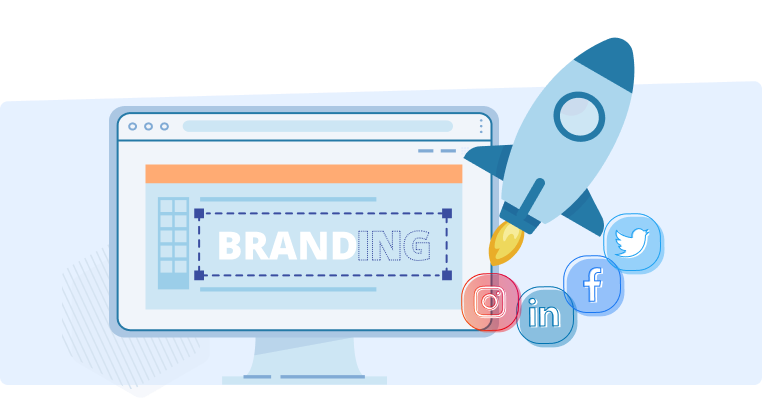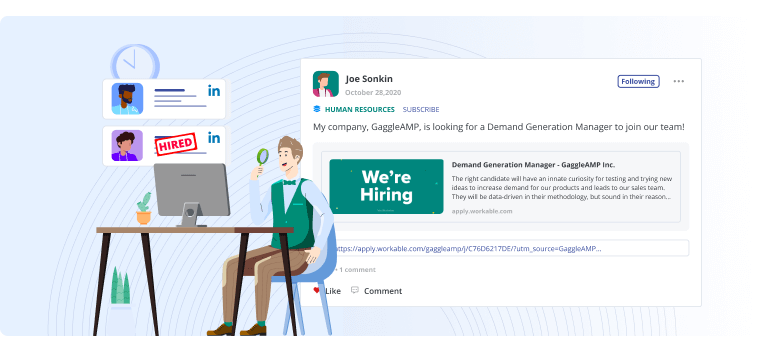Everything You Need to Build a Strong Employer Branding on LinkedIn
LinkedIn has become a powerful tool for employers to brand themselves and attract the right candidates. With over 850 million users and a focus on professional networking, it is the go-to platform for employers to showcase their company culture and what it is like to work for them (and with them, too).
Elevating your LinkedIn employer branding can help your reputation as a brand and an employer, which, in turn, will attract top talent who shares the same brand values.
For great employer branding, LinkedIn should be used to its fullest potential. We’re going to teach you everything you need to know to build a powerful brand image on LinkedIn plus share some of the best employer branding examples.
Ready? Let’s get started.
Employer Branding on LinkedIn: Definition
Employer branding on LinkedIn refers to the process of building and promoting a positive company image, reputation, and narrative on LinkedIn. This involves creating and sharing content that showcases the company’s culture, values, recruitment style, and achievements to attract top talent.
By sharing this content, it will give potential employees an opportunity to see what it’s like working for your company. Ideally, they will love what they see and will apply to an open position.
Key Aspects of Employer Branding on LinkedIn
A powerful brand isn’t born overnight — it takes time and dedication. But you can speed up the process by identifying your unique employer value proposition, or EVP (e.g., the value a company can offer a potential employee).
Here are five key aspects of employer branding on LinkedIn to consider for your EVP:
1. Company Culture and Values
At the top of the list is showcasing the company’s culture and values. If you search “employer brand LinkedIn,” you’ll find that the number one obstacle candidates face when looking for a job is not knowing what it’s like to work for a specific company, and a whopping 75% take the company’s brand into consideration before even applying.
It goes without saying that the culture you’re promoting should be positive and inclusive and that your values align with your mission and vision.
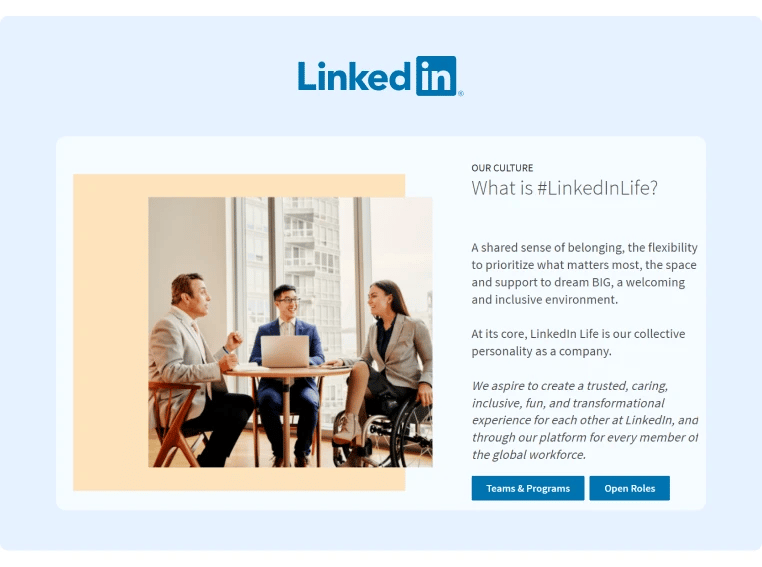
Source: LinkedIn
2. Employee Recognition
Employees want to feel valued, and an employee recognition program is a great way to recognize their contributions to the company. The recognition needs to be genuine, and ideally, on a consistent basis (e.g. once a month, every quarter, etc.). Keep in mind that each employee has a different preference on how they want to be recognized. Before you implement your program, try to get a clearer picture of your employees’ language of appreciation (e.g., raises, bonuses, gift cards, activities, etc.).
Recognizing and showcasing employee achievements will build a positive work culture and show that the company values and supports its employees. This, in turn, will lead to increased productivity and 4x greater employee engagement at work.
Here’s an example of a CEO recognizing their longest-serving employee for his valued contributions to the company.
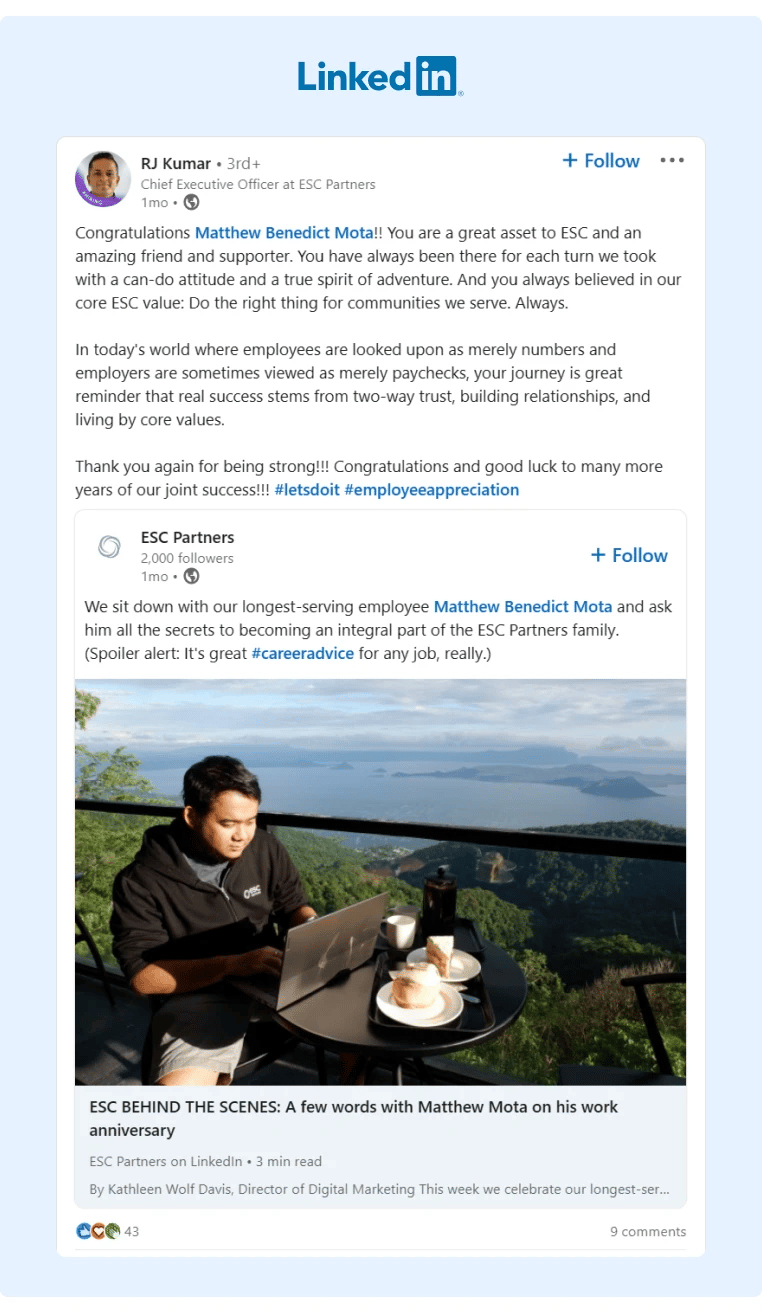
Source: RJ Kumar
3. Work-Life Balance
For many candidates, work-life balance is a factor when applying for a position. When creating your employer branding strategy, be sure to explain how your company supports work-life balance. In your job description and/or benefits, include (if applicable) flexible hours, remote or hybrid work opportunities, etc.
Being transparent will go a long way with potential candidates who value high-trust companies. And if you’re a high-trust company, it’s reported that employees experience a 74% reduction in stress and a 50% increase in productivity. That’s a win-win for both employees and the company!
4. Equal Opportunity Employer
An equal opportunity employer is a company that agrees not to discriminate against employees based on their race, religion, color, national origin, gender, sexual orientation, age, veteran status, or disability status.
Strong employer branding companies will post an equal opportunity statement in their job postings. This can also include sharing policies and initiatives that support these values and highlighting the diversity of the company's workforce.
In this example, Amino Health’s culture section includes their equal opportunity employer policy.
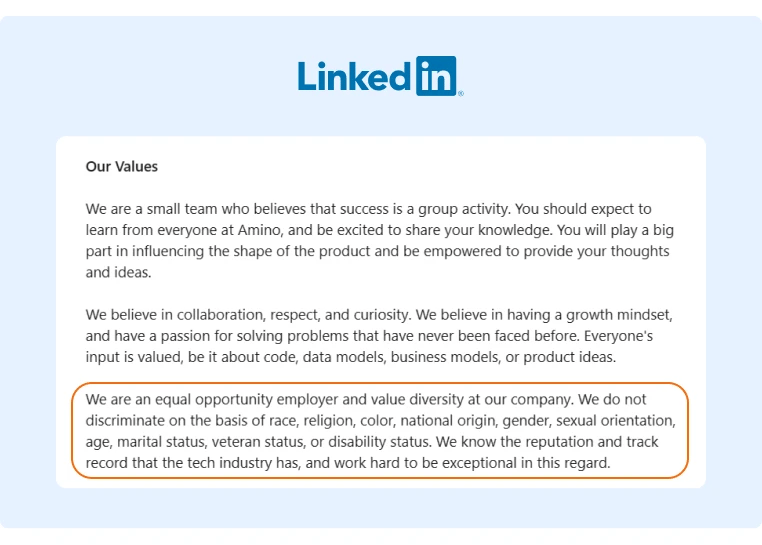
Source: Amino Health
5. Social Responsibility
When creating your employer branding strategy, make sure to share your commitment to social responsibility. Employer branding statistics show:
- 92% of people would consider changing jobs to a company with a great reputation.
- 71% of consumers have stopped buying from a brand after hearing that the company treated employees badly.
In fact, 90% of shoppers worldwide are likely to switch to brands that support a good cause.
Some ways to highlight your social responsibility are showcasing charitable initiatives, sustainability efforts, and other ways that the company gives back to the community.
Here, Berger Paints India shares how they supported healthcare professionals and the community.
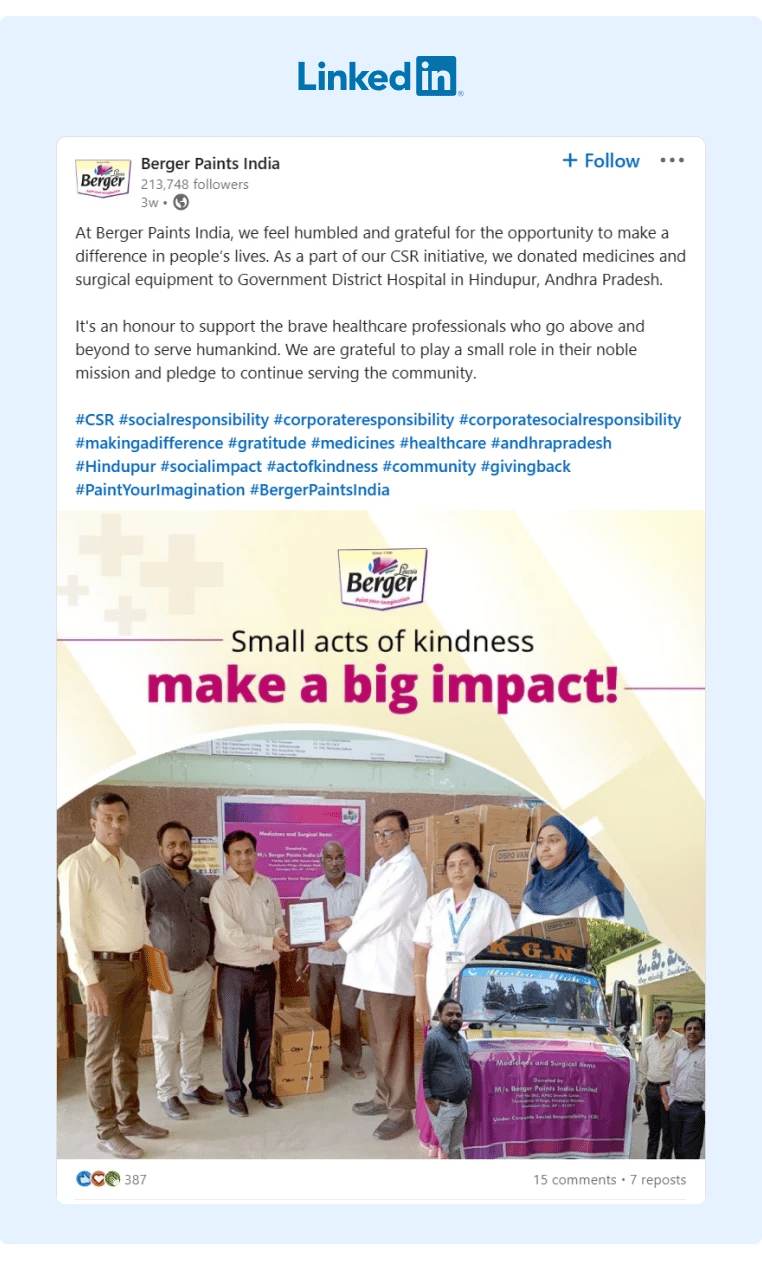
Source: Berger Paints India
Benefits of Employer Branding on LinkedIn
We’ve talked about what key aspects to take into consideration when creating your branding strategy, and we’ve looked at some employee branding examples LinkedIn company profiles featured. Now let’s see why is employer branding important.
Decreases Time and Cost per Hire
By attracting the right candidates who align with the company's values and culture, the hiring process becomes more streamlined and efficient. As a result, employers can save time and money on recruiting efforts. In fact, positive employer branding in recruitment can reduce the cost per hire by up to 50%.
Increases Retention
The answer to the question “What is employer branding in HR?” is directly connected with the goal all companies want to achieve – saving money on hiring. Employer branding on LinkedIn can help increase retention by attracting candidates who are a good fit for the company's values. These candidates are more likely to be satisfied with their job and remain with the company for a longer period of time. A reduction in turnover rate will help productivity and overall performance, too.
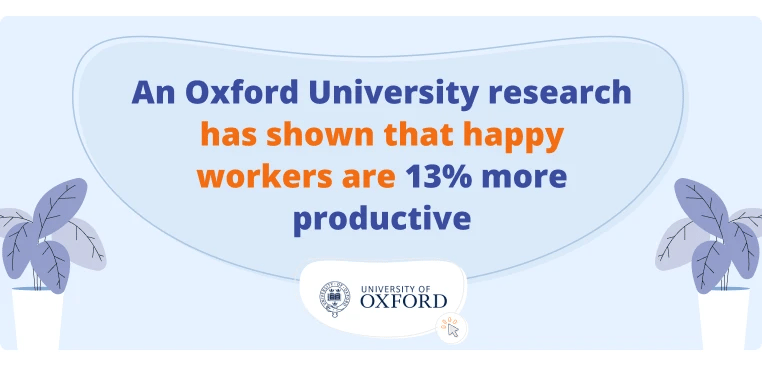
Source: University of Oxford
Establishes Credibility
By building a positive reputation on LinkedIn, employer branding can help establish credibility for the company. Candidates are more likely to trust and feel confident in an organization that has a strong online presence and a reputation for being a great place to work. In fact, half of all candidates would turn down a job with a bigger salary if the company has a bad reputation.
Boosts Employee Morale and Engagement
Employer branding on LinkedIn can boost employee morale and engagement because the pride that employees feel when working for a company with a great reputation is contagious and spreads among them quickly. You can build your employer brand by taking care of your employees' career growth, investing in training and support, offering competitive compensation, or flexible working hours.
Employer Branding Strategy for LinkedIn
Let's dive into employer branding best practices for building a positive image on LinkedIn next. So, how do you brand your company on LinkedIn? Here are five key steps:
1. Identify Your Brand Messaging
A strong brand messaging strategy is crucial for creating a lasting impact on LinkedIn. This involves developing a compelling story about the company's mission, values, and culture. It's important to use clear and concise language that resonates with potential candidates. Copywriting and storytelling play a significant role in creating a strong brand image that sets the company apart.
2. Be Transparent
Transparency is one of the best employer branding strategy examples. Not only do you want to be transparent about your company’s values and mission, but particularly in your job openings. Be as specific as possible about the position’s description and benefits. This will build trust with potential candidates who will know exactly what they’re applying for. Today’s job seekers won’t waste time on vague job descriptions.
In this example, the company includes the position title, salary range, and a link to apply.
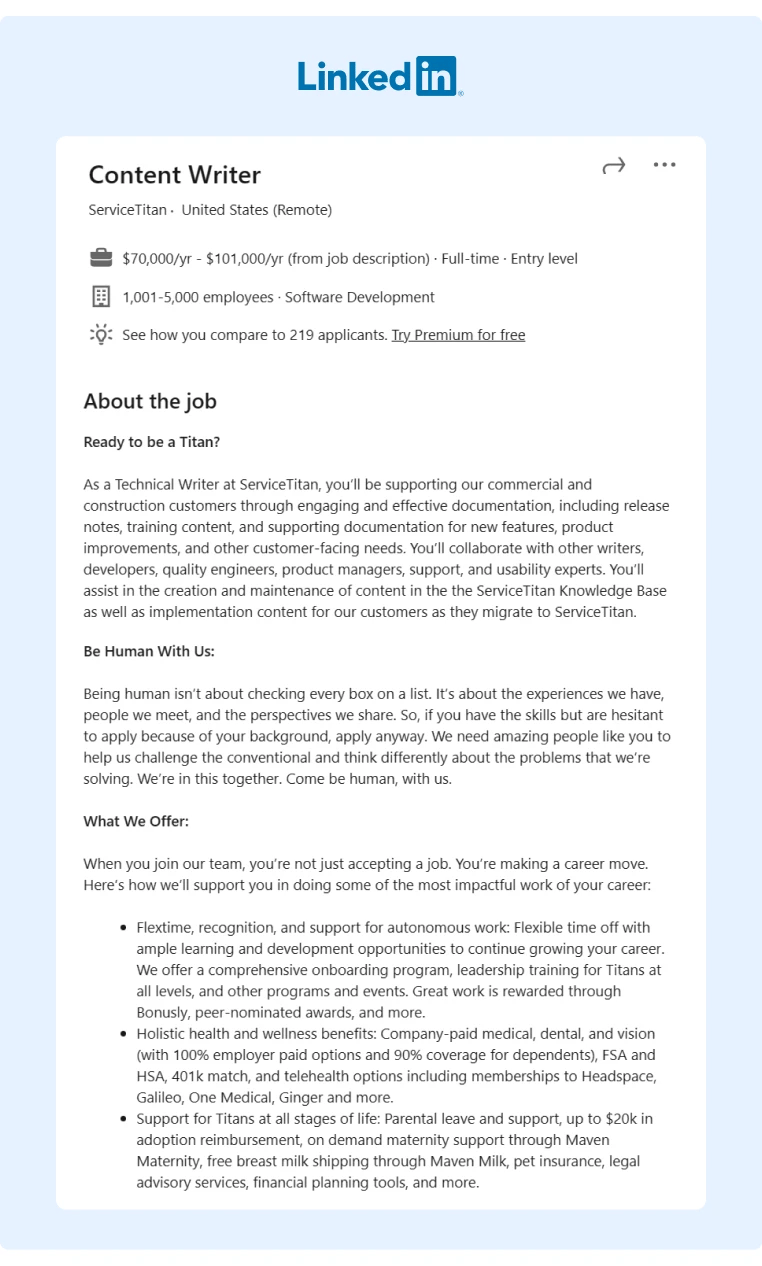
Source: ServiceTitan
3. Create a Candidate Persona
One of the often overlooked employer branding activities in recruitment is creating a candidate persona. This can help employers tailor their messaging to attract the right candidates. The persona needs to identify the ideal candidate's characteristics such as skills, experience, and values. Once the persona is defined, the employer can craft messaging that resonates with this potential candidate.
4. Take Care of Your Employees
Surely, you’re familiar with the most important internal employer branding strategy: When employers take care of their employees, the employees are more likely to take care of the business. Automation tools can help ease the process of engagement and motivate employees through gamification. By boosting employee engagement and productivity, the company can build a positive reputation that attracts top talent. It’s a win-win strategy both for employee branding and employer branding.
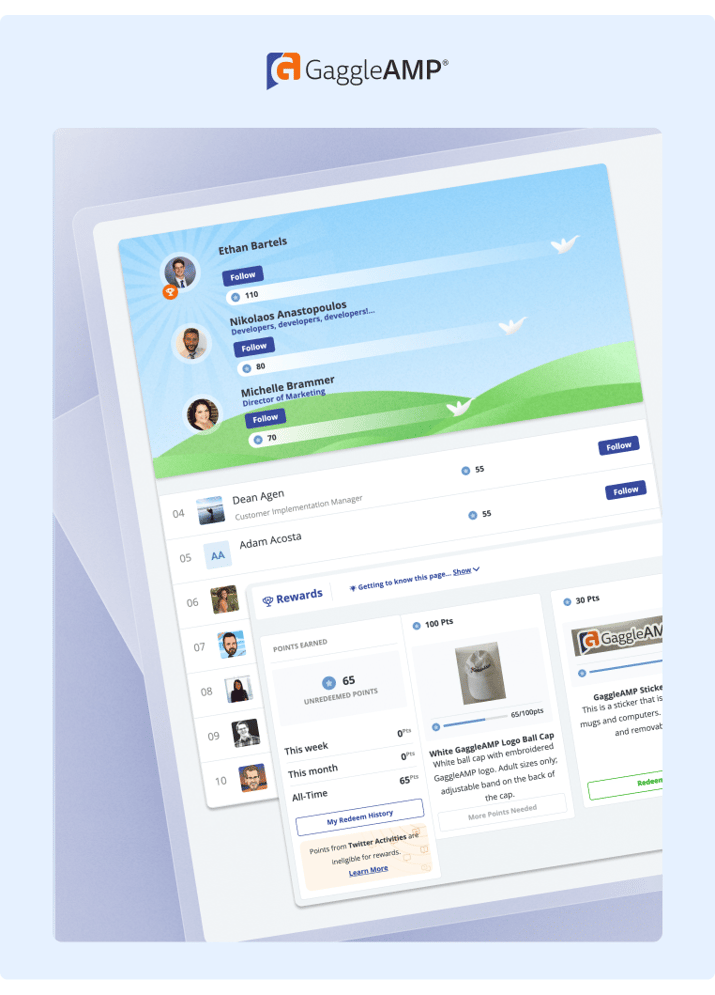
5. Keep Your Company and Career Pages Always Up-to-Date
Keeping company and career pages up-to-date is crucial for building a positive employer brand. This includes updating job openings, company information, and other relevant content. By regularly updating these pages, the employer can showcase the company's growth and commitment to transparency.
GaggleAMP: A Must-Have Tool for Employee Branding and Employer Branding
In the age of AI, it is more important than ever to humanize your brand as an employer. We at GaggleAMP know the value of human connections and the exchange of ideas, so we have created the best platform that helps in driving engagement across all digital channels.
Our software helps your employer branding on LinkedIn and all the major platforms by keeping employee morale and engagement fresh by offering incentives and gamification. It also makes it ridiculously easy for employees and stakeholders to share content with their networks.
Request a demo today and let’s level up your employer branding – your employees and your business will thank you!





